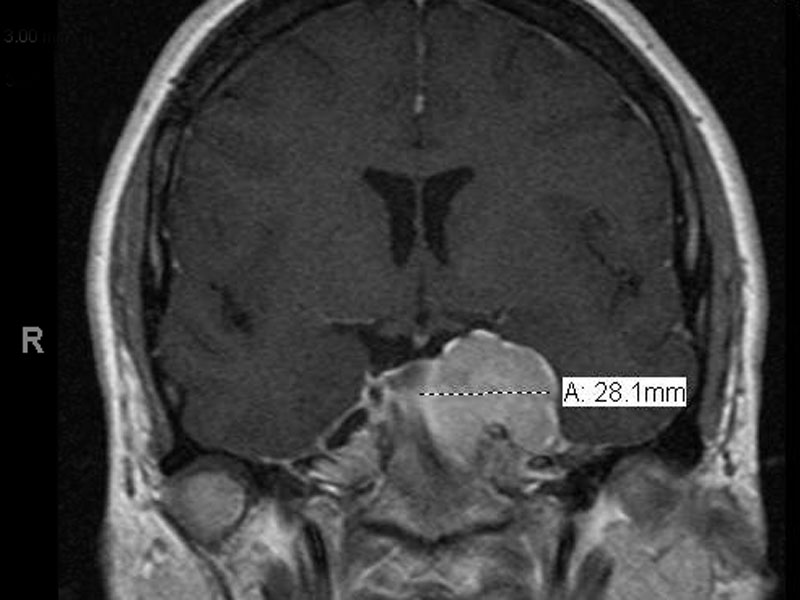

The MRI shows a dural based mass along the left tentorium extending and causing mild mass effect upon the medial temporal lobe. This extends laterally down the clivus and over the sella turcica. The lesion abuts the optic chiasm.
Case 1: Polygonal cells with pink and vacuolated cytoplasm form trabeculae against a myxoid background, resembling a chordoma.
Alcian blue highlights the myxoid background.
The left portion of the image shows more typical meningioma morphology while the right portion shows a more loose, chordoid appearance.
Yet another image demonstrating the interface between the more typical spindled/epithelioid appearance of more usual type meningioma (top image) and the looser myxoid appearance of the chordoid phenotype.
Most meningioma subtypes are considered WHO Grade I tumors, but the clear cell and chordoid variants exhibit more aggressive behavior and along with atypical meningiomas, are considered WHO Grade II Tumors.
Histologically, round or polygonal cells with eosinophilic cytoplasm resembling chordoma cells (some with vacuolated cytoplasm) form short cords or small nests against a mucoid background. Features associated with a more aggressive meningioma (e.g. increased mitotic activity, prominent nucleoli) is often present as well.
The chordoid variant pattern typically is seen as a focal area mixed with other types of meningioma. The exact percentage of chordoid necessary to designate the tumor as a chordoid variant has not been defined.
There have been several case reports describing chordoid meningioma associated with Castleman Syndrome (Bruno, Kaloshi). Histologically, these tumors exhibit chordoid features along with lymphoplasmacellular infiltrates containing follicles and germinal centers. It is proposed that the tumor may elaborate cytokines (especially IL-6) which contribute to the development of systemic symptoms seen in Castleman syndrome (Arima). However, some larger series have not found an association of chordoid meningioma with Castlemen (Lin, Couce).
Interestingly, some chordoid meningiomas are also described in conjunction with polyclonal gammopathies, an association usually found in lymphoplasmacyte-rich variant of meningiomas (Bruno, Loh). These must be some association between chordoid and lymphoplasmacyte-rich meningiomas as both can contain lymphoplasmacytic infiltrates and elicit peripheral blood abnormalities. It is not clear (to this author) what the connection might be.
There is greater tendency to recur after subtotal resection, and are therefore designated WHO grade II.
• Meninges : Meningioma, Transitional Variant
• Meninges : Meningioma, Fibrous Variant
• Meninges : Meningioma, Meningotheliomatous (Syncytial) Variant
• Meninges : Meningioma, Anaplastic Variant
• Meninges : Atypical Meningioma
• Meninges : Meningioma, Angiomatous Variant
• Meninges : Meningioma, Clear Cell Variant
• Meninges : Meningioma, Microcystic Variant
• Meninges : Meningioma, Psammomatous Variant
• Meninges : Meningioma, Secretory Variant
• :
Arima T, Natsume A, Hatano H et al. Intraventricular chordoid meningioma presenting with Castleman disease due to overproduction of interleukin-6. Case report. J Neurosurg. 2005 Apr;102(4):733-7.
Bruno MC, Ginguené C, Santangelo M et al. Lymphoplasmacyte rich meningioma. A case report and review of the literature. J Neurosurg Sci. 2004 Sep;48(3):117-24; discussion 124.
Couce ME, Aker FV, Scheithauer BW. Chordoid meningioma: a clinicopathologic study of 42 cases. Am J Surg Pathol. 2000 Jul;24(7):899-905.
Kaloshi G, Antonelli M, Vreto G et al. Report of two cases of chordoid meningioma in patients with Castleman syndrome. J Neurooncol. 2010 Dec 7. [Epub ahead of print]
Kepes JJ, Chen WY, Connors MH et al. "Chordoid" meningeal tumors in young individuals with peritumoral lymphoplasmacellular infiltrates causing systemic manifestations of the Castleman syndrome. A report of seven cases. Cancer. 1988 Jul 15;62(2):391-406.
Lee DK, Kim DG, Choe G et al. Chordoid meningioma with polyclonal gammopathy. Case report. J Neurosurg. 2001 Jan;94(1):122-6.
Lin JW, Ho JT, Lin YJ, Wu YT. Chordoid meningioma: a clinicopathologic study of 11 cases at a single institution. J Neurooncol. 2010 Dec;100(3):465-73. Epub 2010 May 9.
Loh JK, Hwang SL, Tsai KB, et al. Sphenoid ridge lymphoplasmacyte-rich meningioma. J Formos Med Assoc. 2006 Jul;105(7):594-8.